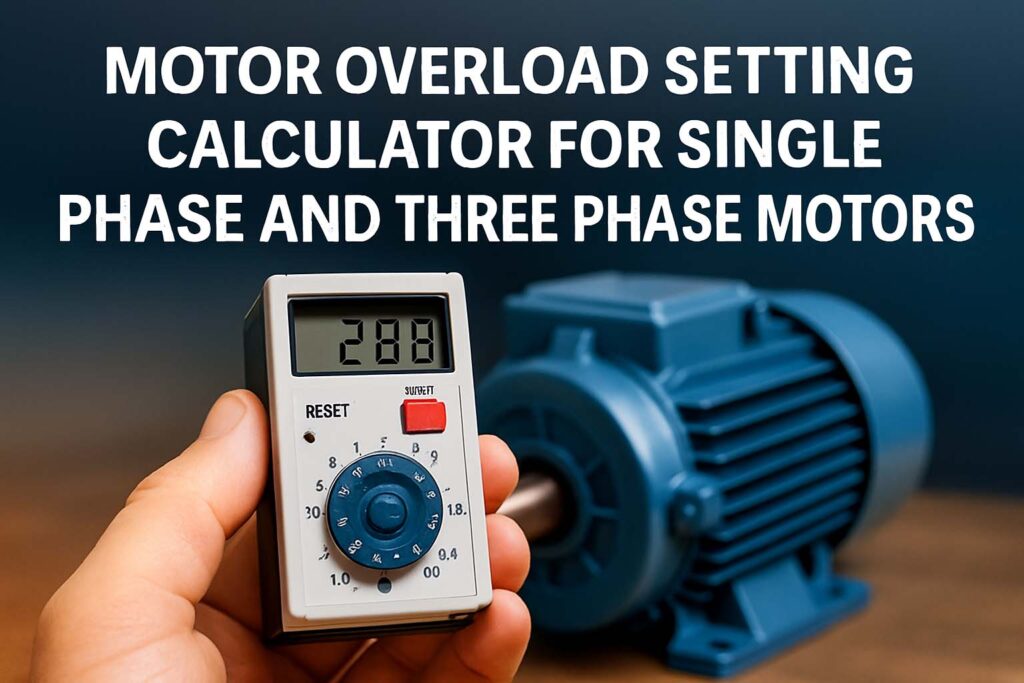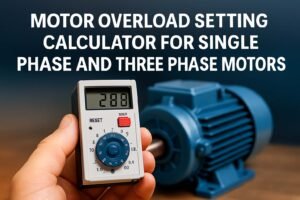Motor Overload Setting Calculator for Single and Three Phase Motors
Electric motors are the heart of countless machines, tools, and appliances. From industrial motors driving pumps and compressors to small motors in household equipment, protecting these devices from overcurrent damage is crucial. That’s where overload protection comes into play. Overload relays help ensure motors are protected from excessive heat and current, which can lead to insulation damage, burnout, and even fire. But how do you determine the correct overload setting for a motor? The answer lies in using a Motor Overload Setting Calculator.
Table of Contents

Whether you’re working with a single-phase motor or a three-phase motor, proper overload setting is essential. Incorrect settings can either cause frequent nuisance trips or fail to protect the motor when needed. That’s why using a well-designed and accurate Motor Overload Setting Calculator helps engineers, technicians, and electricians save time, ensure safety, and increase equipment life.
This article explores how a Motor Overload Setting Calculator works, how to set it for different motor types, and why it is essential in your electrical design and maintenance toolbox.
Key Takeaways:
- A Motor Overload Setting Calculator determines the correct trip setting based on motor full load current.
- For single-phase and three-phase motors, overload protection ensures the motor runs within thermal limits.
- Accurate settings prevent damage and reduce downtime caused by false tripping or overload faults.
Understanding Motor Overload and Why It Matters
Before we talk about the calculator, let’s understand what motor overload is. A motor is considered overloaded when it draws more current than its rated full-load current (FLC) for an extended period. This excess current causes the motor windings to heat up, which can deteriorate insulation and reduce motor life.
Overload relays are protective devices that monitor motor current. If the current exceeds the preset limit for a specified time, the relay disconnects the motor to prevent damage. However, these relays must be correctly set, and that’s where a Motor Overload Setting Calculator becomes valuable.
A calculator uses inputs such as motor rating (kW or HP), voltage, phase (single or three), and efficiency to compute the Full Load Current and recommend a trip setting based on standards like IEC or NEMA.
Use our online tool Circuit Breaker Size Calculator for Appliances
What is a Motor Overload Setting Calculator?
A Motor Overload Setting Calculator is a tool that helps determine the correct overload protection setting for a motor. It simplifies the otherwise technical and time-consuming task of referring to motor datasheets, applying correction factors, and checking standard tables. By automating the process, it ensures accurate protection levels.
The calculator takes the following inputs:
- Motor Power (kW or HP)
- Motor Voltage
- Power Factor (optional)
- Motor Efficiency (optional)
- Motor Phase (Single or Three)
- Ambient Temperature (optional for derating)
And it provides:
- Full Load Current (FLC)
- Overload Relay Setting (% of FLC)
- Recommended Trip Current
These values are based on IEC 60947-4-1 or NEMA MG1 guidelines depending on regional standards.
Use our online tool Watt to Amp Calculator (Single & Three-Phase): Best Tool
How to Calculate Motor Overload Settings
Let’s look at how you can use formulas for manual calculation to understand the backend of the calculator.
Single Phase Motor Overload Setting Formula:
Full Load Current (FLC) for Single Phase:
FLC = (Motor Power in Watts) / (Voltage × Power Factor × Efficiency)
Then,
Overload Relay Setting = FLC × 1.15 (usually set at 115% of FLC for general purpose motors)
Three Phase Motor Overload Setting Formula:
FLC = (Motor Power in kW × 1000) / (√3 × Voltage × Power Factor × Efficiency)
And,
Relay Setting = FLC × 1.15 (as per standard)
These calculations are simplified in a Motor Overload Setting Calculator, where you only need to provide input values and let the calculator do the rest.
Use our online tool House Wiring Cable Size Calculator – Safe and Efficient Sizing for Home Circuits
Recommended Overload Settings for Motors
| Motor Type | Standard Overload Setting Range | Notes |
|---|---|---|
| General Motors | 115% of Full Load Current | Based on standard ambient |
| High Ambient Area | 105-110% of FLC | Derating required |
| Continuous Duty | 100-110% of FLC | Depends on duty cycle |
| Intermittent Duty | Up to 120% of FLC | Short-term overloads permissible |
Using a calculator that incorporates these ranges ensures consistency with industry standards.
Why You Should Always Use a Motor Overload Setting Calculator
There are three major reasons:
- Accuracy: Manual calculation is prone to errors, especially with varying power factors, efficiencies, or voltage drops. A calculator eliminates guesswork.
- Speed: Instead of checking catalogs, datasheets, or standards tables, you enter values and get results instantly.
- Compliance: Many electrical safety inspections require proof that protection settings are compliant with standards. A Motor Overload Setting Calculator offers reliable references.
Motor Overload Relay Setting Examples
Let’s run through a few examples to show how calculations work.
Example 1: Single Phase Motor
- Motor Rating: 2 HP
- Voltage: 230V
- Efficiency: 85%
- Power Factor: 0.9
Use our online tool Amps to Wire Size Calculator – Choose the Right Cable for 10A, 20A, 40A Loads
FLC = (2 × 746) / (230 × 0.9 × 0.85) = 8.2 A
Relay Setting = 8.2 × 1.15 = 9.43 A
Example 2: Three Phase Motor
- Motor Rating: 5 HP
- Voltage: 400V
- Efficiency: 90%
- Power Factor: 0.85
FLC = (5 × 746) / (1.732 × 400 × 0.85 × 0.90) = 7.06 A
Relay Setting = 7.06 × 1.15 = 8.12 A
These examples show how easily you can arrive at overload settings using a calculator. For technicians in the field, this saves time and prevents dangerous mistakes.
Common Mistakes When Setting Motor Overload Protection
While a Motor Overload Setting Calculator simplifies the process, it’s important to avoid these common errors:
- Ignoring Duty Cycle: Not all motors are used continuously. Intermittent duty motors can have higher allowable overloads.
- Using Incorrect Voltage Ratings: Many calculators assume a standard voltage. You must input the actual system voltage.
- Skipping Efficiency Factor: A small change in efficiency significantly alters full load current.
- Not Considering Ambient Temperature: High temperatures require derating, which must be accounted for.
Use our online tool Online Wire Gauge Calculator for 1 Phase and 3 Phase Load – Amp and Distance Based
Best Practices When Using a Motor Overload Setting Calculator
- Always verify motor nameplate data before input.
- Ensure the relay you are using supports the calculated setting range.
- For critical applications, set the relay slightly below 115% to offer early protection.
- Cross-check with manufacturer datasheets if available.
These best practices enhance motor longevity, reduce breakdowns, and ensure energy efficiency.
Applications of the Motor Overload Setting Calculator
- Industrial Automation: Motor panels in factories rely on overload settings for operational safety.
- HVAC Systems: Fans and compressors must be protected from locked rotor currents.
- Agricultural Pumps: Especially in rural grids, overload protection prevents failures during voltage dips.
- Home Workshops: Even single-phase motors in small tools require proper settings for safe use.
Whether you’re designing a new system or retrofitting an old one, overload protection remains a core safety feature.
Conclusion: The Value of Motor Overload Setting Calculators
Protecting your motors is not optional—it’s essential. Overload conditions are one of the most common causes of motor failure, and the cost of replacing a damaged motor far exceeds the effort required to set the correct overload protection. Using a Motor Overload Setting Calculator simplifies this task, ensures accuracy, and aligns your design with industry standards.
Whether you’re dealing with a small single-phase motor in a home workshop or a large three-phase motor in an industrial plant, overload setting calculators are your best companion for motor protection. They bring technical precision, regulatory compliance, and peace of mind—all at the click of a button.
Follow Us on Social:
Subscribe our Newsletter on Electrical Insights to get the latest updates in Electrical Engineering.
#MotorOverloadSettingCalculator, #OverloadRelay, #MotorProtection, #SinglePhaseMotor, #ThreePhaseMotor, #OverloadRelaySetting, #ElectricalCalculator, #MotorCurrentCalculation, #ElectricMotorSafety, #OverloadProtection, #3PhaseMotor, #MotorControl, #ElectricalEngineeringTools, #IndustrialAutomation, #MotorSizing
Motor Overload Setting Calculator for Single and Three Phase Motors : Electrical Engineering Hub

Easily calculate motor overload relay settings with our Motor Overload Setting Calculator. Improve motor protection, efficiency, and reliability in your system
Price Currency: USD
Operating System: All
Application Category: UtilitiesApplication

It is actually a nice and helpful piece of information. I?¦m happy that you shared this helpful information with us. Please stay us informed like this. Thank you for sharing.